Award of Merit Presented to California State Parks Dive Team
Story from: Ken Kramer, Training Section
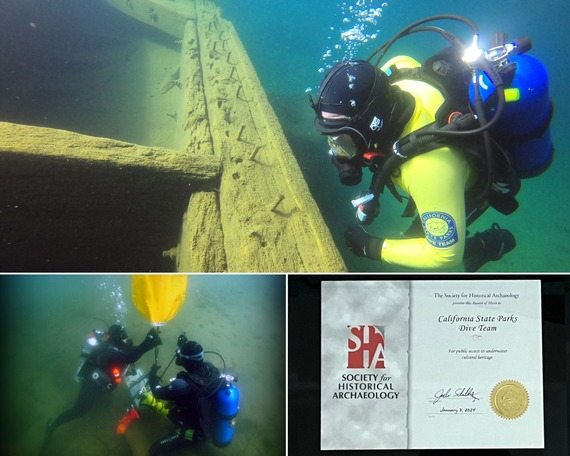 Top: Sierra District Supervising Ranger Taylor Jackson conducts a condition assessment of the historic wooden barges, one of four sites that comprise the Emerald Bay SP Maritime Heritage Trail. Bottom left: State Park Divers Dan Shaw and Denise Jaffke install one of four underwater interpretive panels at Emerald Bay SP. Bottom right: The framed SHA Award of Merit. Photos from Training Section.
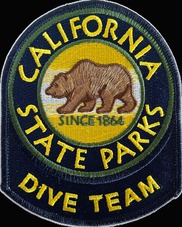
During its 57th Annual Conference held in Oakland, California, on Wednesday, January 3, the Society for Historical Archaeology (SHA) presented a special Award of Merit to the California State Parks Dive Team for Public Access to Underwater Cultural Heritage.
The SHA Awards of Merit were established in 1988 to recognize the specific achievements of individuals and organizations that have furthered the cause of historical archaeology. The award is especially meaningful as it highlights the multidisciplinary capabilities of the department's diving program, which includes maintaining expertise in scientific diving, underwater interpretation and education outreach, public safety diving, submerged facilities maintenance and scuba-related training.
The SHA award recognizes the dive team for their longstanding work to develop, install and maintain the Emerald Bay State Park (SP) Maritime Heritage Trail, which opened to the public in 2018 and highlights four representative examples of well-preserved, early 20th-century sunken wooden boats and barges.
The concept for preserving and interpreting submerged resources at Emerald Bay SP and Rubicon Point at D.L. Bliss SP was first formally proposed by the department's Advisory Board on Underwater Parks and Reserves in 1979. In 1989, following the approval of the director and the State Park and Recreation Commission, a 49-year lease agreement between State Parks and the State Lands Commission for management and public use of the underwater areas was executed and remains valid until 2038.
Hopefully, the Emerald Bay SP Maritime Heritage Trail will serve as a model for similar future projects to promote underwater recreation, natural and cultural resource management, and interpretation at some of the department's other 21 underwater areas identified in List 4 of the State Parks 2022 Planning Milestones report.
|
Lake Perris Uses New Technology to Reunite Family
Story and photos from: Pete Estes, Law Enforcement and Emergency Services Division
 Left: Carolyn Williams reunited with her son, Travonn. Top right: Carolyn and State Park Superintendent John Rowe. Bottom right: Carolyn's black Acura sedan captured by FLOCK camera leaving Lake Perris State Recreation Area.
State Parks Dispatch received a 911 transfer on Dec. 21, 2023, from a park visitor at Lake Perris State Recreation Area. Carolyn Williams was panicked and reported that her vehicle was stolen. Unbeknownst to the dispatcher, Carolyn suffers from dementia, among other medical conditions, and had taken her son’s vehicle and left the park. State Park Superintendent John Rowe received the call and met with Carolyn’s son, Travonn, who was in tears and extremely worried. He explained he has been taking care of her for the last five years, she was not allowed to drive a car and had not driven in over 10 years. Travonn feared that the worst could happen; Carolyn has numerous medical conditions and gets confused very easily. Unfortunately, Travonn could not provide the vehicle license plate, nor did he know which direction his mother went.
Historically state park peace officers (SPPOs) would then be faced with a needle-in-a-haystack situation. They would be tasked with trying to locate a vehicle based on make and model in a sea of people and vehicles in Riverside County. SPPOs would advise surrounding agencies, and as officers patrolled, they would keep an eye out for the vehicle. Media outlets would announce a Silver alert, and numerous resources would be deployed.
Luckily for Travonn, Lake Perris is currently piloting a new vehicle camera system at their entrance and exit locations. This technology solution is called FLOCK and is widely used by police agencies across the country. FLOCK is a mounted camera system that deploys automated license plate acquisition technology and uses artificial intelligence to identify vehicles that have been entered into the system. FLOCK maintains a database of vehicles and will notify officers if a vehicle passes a camera and the vehicle is wanted for a variety of reasons, typically serious felonies or Amber and Silver alerts. Surrounding agencies can share their camera information and send alerts, allowing our partners to advise us if a potentially dangerous individual is entering a state park or we can advise them if we know a wanted vehicle has left our park.
In this case, Superintendent Rowe quickly accessed his FLOCK app and made a search looking for all black Acura sedans triggering a Lake Perris FLOCK camera within the last hour. Superintendent Rowe was able to confirm the vehicle from the FLOCK image captures. The image clearly showed the license plate, which was used to enter the vehicle into FLOCK as a missing/endangered person.
Superintendent Rowe determined Carolyn’s direction of travel and advised surrounding agencies. Riverside Sheriff’s picked up Carolyn using their FLOCK system and determined she was traveling westbound, 30 minutes later Riverside Sheriff’s located Carolyn in Lake Elsinore and were able to safely stop her and begin the reunification process. When Superintendent Rowe told Travonn that his mother was found in Lake Elsinore, he was ecstatic and said they used to live there over 15 years ago.
The system is a huge step forward for officer safety and the safety of all State Parks staff. Inland Empire Chief Ranger Mike Dippel said, “This is a great example of exactly why this software is so important to our officers as we continue moving into modern policing and how it allows us to integrate with other agencies and use all the tools at our disposal to protect the people of California.”
FLOCK gives officers time to make reasoned decisions as opposed to having to make reactive decisions. If a car is labeled as stolen, they can take a step back, get additional officers and plan an approach.
Travonn and Carolyn were so thankful and happy to be reunited so quickly. Travonn was able to pick his mother up from Lake Elsinore, bring her back and finish their camping trip at Lake Perris. A great start to their holiday season.
Securing the Future: Anza-Borrego Desert State Park’s Commitment to Endangered Species Management
Story from: Danny L. McCamish, Colorado Desert District
 Volunteers move empty tanks into area to set up CDFW bighorn sheep biologist. Photo by John Taylor, Colorado Desert District.
In an extraordinary collaborative effort, Anza-Borrego Desert State Park (SP) is happy to report continued efforts toward the conservation of the endangered and titular Borrego or Peninsular bighorn sheep, Ovis canadensis nelsoni. Thanks to a generous donation from Sycuan Casino and the Sycuan Band of the Kumeyaay Nation—alongside key partnerships with the California Department of Fish and Wildlife (CDFW) and over 30 volunteers from the Wild Sheep Foundation (CAWSF), Backcountry Hunters & Anglers (BHA), BHA Armed Forces Initiative, the United States Marine Corps and Anza-Borrego Desert SP Natural Resources Management and CDFW biologists—teams successfully on Nov. 4-6, 2023, completed maintenance replacement of four 2,500-gallon “rain-catchment” tanks within the park.
Sycuan Casino and the Sycuan Band of the Kumeyaay Nation’s substantial donation to Anza-Borrego Desert SP and the Anza-Borrego Foundation paved the way for this ongoing endangered species conservation management effort, providing the necessary funds for all the water tank purchases. CAWSF and BHA donated ancillary supplies necessary to plumb and make the new tanks functional. This collaborative effort showcases the positive impact that public-private partnerships can have on preserving our delicate desert ecosystems and promoting conservation.
The Anza-Borrego Desert SP and CDFW group management action focused on the scheduled 20-year replacement of two historic “water catchment” wildlife-guzzler seasonal water systems within the park. This initiative aligns with the U.S. Fish and Wildlife Recovery Plan for bighorn sheep in the Peninsular Ranges, emphasizing the critical role of providing sustainable and monitored seasonal water sources for the sheep.
These two wildlife guzzler catchment tanks that were replaced, strategically located near Whale Peak and Harper Flat, are part of a larger network of backcountry seasonal wildlife water guzzlers. Drinking systems are turned “off” during the seasonally “rainy” winter and spring months to allow for catchment and retention of seasonal rain in the water tanks to use during the “hot” or dry summer and fall months to provide an available summer water resource location. The guzzler box provides the tank-stored water through an attached “self-refilling wildlife drinker box” for the local wildlife, particularly the endangered bighorn sheep, to drink during and within the driest parts of the summer. Ensuring the longevity and functionality of these replacement water systems are paramount, along with ongoing monitoring and ecosystem studies, to the continued bighorn sheep management goals and the survival and well-being of this iconic species.
In a collaborative effort involving volunteered helicopter operations and flight crews, U.S. Marines from Marine Light Attack Training Squadron 303 played a crucial role in removing old water tanks and transporting and installing the new multiple 2,500-gallon water catchment tanks in remote areas. In addition to replacing the water guzzlers, the Marines assisted in retrieving tracking collars from deceased bighorn sheep to contribute to ongoing wildlife population monitoring.
As we celebrate the successful completion of this endangered species management action, it serves as a reminder that the future of our desert—and, really, all of our desert ecosystem—relies on the shared responsibility of individuals, organizations and conservation groups. Anza-Borrego Desert SP continues to stand as a beacon of research, conservation, recreation and wilderness values—demonstrating what can be achieved when diverse stakeholders unite for a common cause: preserving our unique and endangered wildlife.
Read the full article about the conservation management operation here.
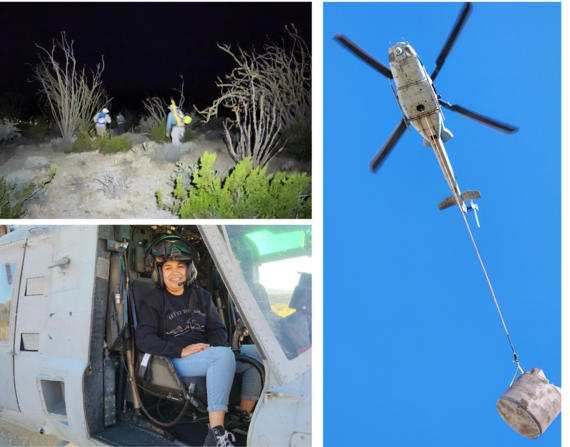 Clockwise from top left: Volunteers begin the hike to the guzzler sites before dawn to be ready for early helicopter operations. U.S. Marine Corps (USMC) helicopters, using long lines, lifted and transported the new tanks to remote locations. Forestry Aide Emelyn Hernandez learns all about helicopters from USMC pilots at team meet-and-greet before flight operations begin. Photos by John Taylor, Colorado Desert District.
Greater Outdoor Access and Learning Program Celebrates Year-One Achievements
Story from: Erin Gates, North Coast Redwoods District
 Del Norte COE, North Coast Redwoods District and RNSP leadership and staff and several key community partners on the steps of the Howland Hill Outdoor School during the GOAL Program celebration on a cold, rainy day. Thanks to special guest Northern Division Chief Jason DeWall for making it all the way up to Del Norte County for this celebration event. Photo from California State Parks.
Del Norte County Office of Education (COE), Redwood National and State Parks (RNSP), California State Parks North Coast Redwoods District (NCRD) and Redwood Parks Conservancy hosted a celebration on Wednesday, January 10, at Howland Hill Outdoor School, in Crescent City, in honor of the Del Norte COE's Greater Outdoor Access and Learning (GOAL) Program's one-year anniversary. In just one year, this unique partnership between Del Norte COE, RNSP, NCRD and Redwood Parks Conservancy has allowed over 4,000 members of the Del Norte community to connect with their local parks.
In addition to hosting over half of the elementary school children in Del Norte County at Howland Hill Outdoor School in RNSP and half the high school students at various events, the GOAL program has hosted family camping, rafting/kayaking, biking, Passport to History tours, the Hike It Baby/Bring It Outdoors program, Art in the Park, tide pooling, beach cleanups, RNSP and NCRD hikes, and NCRD Junior Lifeguards.
The GOAL Program has been made possible, thanks to the California State Parks Outdoor Equity Grants Program. This program shows that through community collaboration, including partnering with several other city, county and Tribal government offices, we are more empowered to ensure parks are accessible to everyone.
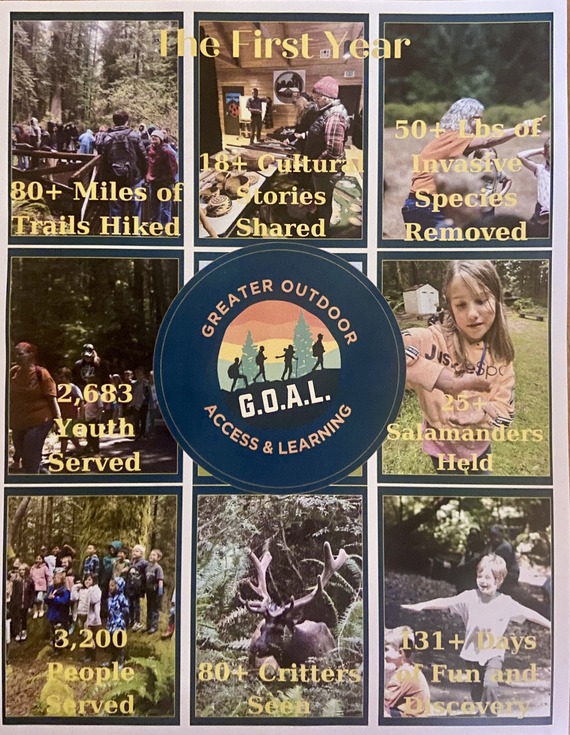 Check out some of the fun statistics collected after just one year of the GOAL program and displayed on these fun fact sheets given to participants at the celebration event.
Youth connecting to redwoods at Prairie Creek Redwoods State Park in July 23, through the GOAL program. Photo from California State Parks.
State Parks Pass Office Offers In-Person Sales in Sacramento
Story from: Blake Anderson, Strategic Planning and Recreation Services Division
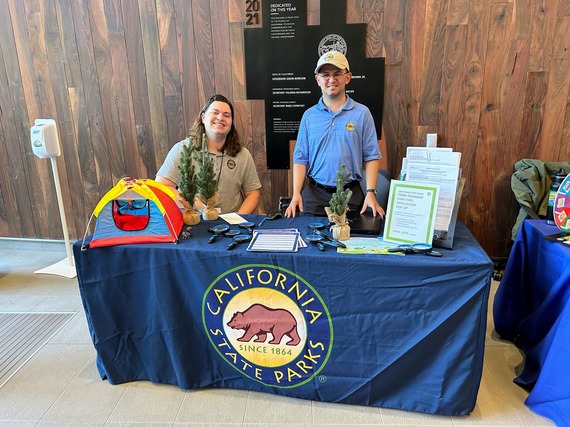 The Pass Office staff with Staff Services Analyst Blake Anderson and Associate Governmental Program Analyst Andrew Shipley showcasing the discount pass programs. Photo from Laurel Brode, Strategic Planning and Recreation Services Division.
The California State Parks Pass Office began offering an in-person monthly pop-up pass sale to the public in Sacramento in March 2023. This is the first year State Parks Headquarters has offered in-person park pass sales since the Pass Office closed to the public in 2020 due to the COVID-19 pandemic. Although other pass sales locations were able to reopen, the Pass Office in Sacramento remained closed while their office relocated to another location.
Since the first pop-up sale, the Pass Office has helped over 100 park visitors in the greater Sacramento area. These visitors purchase annual passes such as the California Explorer, as well as discount passes like the Golden Bear and the Distinguished Veteran. The pop-up sales are held every third Thursday of the month in the lobby of the Natural Resources Agency Headquarters.
The pop-up sales act as a bridge between the Pass Office’s temporary home at the Natural Resources Agency building and their new office at the Heilbron Mansion. Once the mansion renovation is complete—estimated to take place in April 2024—the Pass Office will be able to expand in-person sales and hours of operation to the public.
Luckily for Sacramento pass holders who have already become familiar with the pop-ups, the Heilbron Mansion is directly next door to the Natural Resources Agency Headquarters. This new location will offer increased availability and will help streamline the pass application process for both visitors and employees. In the meantime, the Pass Office will continue to offer pop-up sales on the third Thursday of every month to assist park visitors who require in-person services.
If you are interested in attending one of the Third Thursday Pop-ups, please visit the Third Thursday Pop-up webpage, where you can find all of the scheduled dates and information.
Thousands Participated in First Day Hikes at More Than 60 Participating State Parks
Story from: Doug Johnson, Law Enforcement and Emergency Services Division; Chris Glenn, Northern Buttes District; Richard Fletcher, Monterey District; and Chris Glenn, Northern Butters District
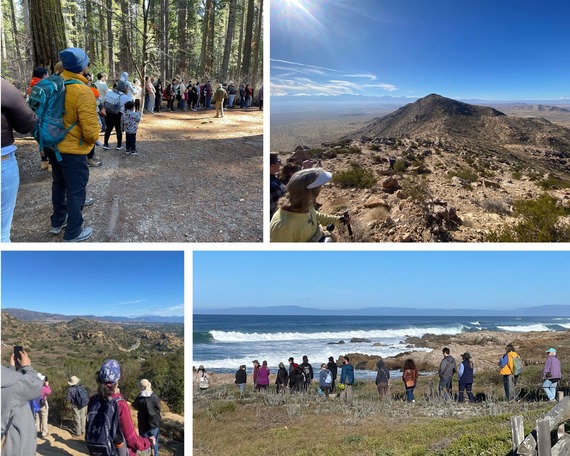 Top left: Around 60 participated in a First Day Hike at Calaveras Big Trees State Park. Photo from Doug Johnson, Law Enforcement and Emergency Services Division. Bottom left: At Santa Susana Pass State Historic Park, 136 people hiked on New Year's Day. Photo from Barbara Tejada, Angeles District. Top right: There were 120 people who participated in the three different hikes at Saddleback Butte State Park. Photo from Lori Wear, Great Basin District. Bottom right: Thirty hikers made the 1.5-mile walk at Asilomar State Beach. Photo from Isabella Brown, Monterey District.
Thousands joined California State Parks staff and volunteers to start 2024 with the annual First Day Hikes on New Year’s Day. More than 60 state parks participated this year with over 80 guided hikes taking place across California.
First Day Hikes is a national-led effort that encourages individuals and families to experience, with a seasoned guide, the beautiful natural and cultural resources found in the outdoors so they may be inspired to take advantage of these treasures throughout the year and an individual’s lifetime. Nationally, more than 66,000 hikers in more than 40 states participated in 2024. That’s up more than 6,000 from 2023.
This year, with the help of the Strategic Planning and Recreation Services Division, California State Parks was able to include an interactive map to our First Day Hikes 2024 website, which allowed visitors to more easily find a First Day Hike in a part of the state they chose.
Many parks reported high turnouts. Chris Glenn, from Northern Butters District, reported more than 100 visitors decided to get a healthy start to 2024 by participating in the 10th annual First Day Hike held at Anderson Marsh State Historic Park in Lake County. Hikers of all ages enjoyed a beautiful, sunny day in the park.
The hike this year covered a 3-mile loop on the park’s trail system and was led by an all-volunteer team of State Parks docents and a State Parks lifeguard. The hikers were divided into two groups to accommodate the large number of visitors, with each group starting in a different direction and passing each other in the middle of the hike.
At Calaveras Big Trees State Park, although it was supposed to be a snowshoeing event, a lack of snow on New Year’s Day created an opportunity for participants to hike instead. Around 60 people attended the guided hike through the parks’ North Grove.
For those in Monterey District, some quick thinking and flexibility were called for after the normal routes for several of the hikes were closed due to storm damage. Interpretive staff and volunteers offered a variety of hikes, historic garden strolls and tabling in Pfeiffer Big Sur State Park, Point Lobos State Natural Reserve, Monterey State Historic Park and Asilomar State Beach and Conference Grounds.
More than 50 hikers, of all ages, met at Quarry Trail at Auburn State Recreation Area on a chilly morning to start the new year for two guided hikes. Staff offered an easy 2.5-hike where participants learned about the geology and mining history of the Middle Fork Canyon. Participants asked staff questions along the way. Additionally, for those feeling more adventurous, Interpreter I Joseph Shananah guided part of the group on a 6.5-mile trek on Quarry Trail, which ascends about 1,000 feet on the Western States and Short Cut Trails. Joseph spoke about the natural resources and transportation history of the area.
A special thanks to GIS Research Data Analyst Krista Schultze for her help setting up the website and to all the staff members and volunteers who guided visitors on their First Day Hikes.
 Top left: Panoramic Overlook at Anza-Borrego Desert State Park. Photo from Pablo Espinosa, Colorado Desert District. Top right: Malibu Creek State Park. Photo from Allison Frye, Angeles District. Bottom left: Ed Z'berg Sugar Pine Point State Park. Photo from Kaytlen Jackson, Sierra District. Bottom right: Fort Ross State Historic Park. Photo from Michelle Levesque, Sonoma Mendocino Coast District.
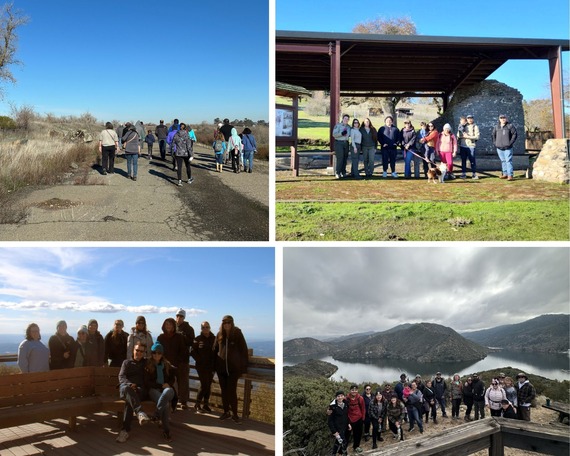 Top left: Salt Point State Park. Photo from Michelle Levesque, Sonoma Mendocino Coast District. Top right: Pacheco State Park. Photo from Caitlin Jackson, Central Valley District. Bottom left: Palomar Mountain State Park. Photo from Will Meyst, Colorado Desert District. Bottom right: Silverwood Lake State Recreation Area. Photo from Caden McWilliam, Inland Empire District.
 Top: Trione-Annadel State Park. Bottom: Van Damme State Park. Photos from Michelle Levesque, Sonoma-Mendocino Coast District.
First Day Ride at Ocotillo Wells State Vehicle Recreation Area
Story and photo from: Cassandra Van Dyne, Ocotillo Wells District
 Left to right: OHMVR Commissioner Tom Lemmon, District Superintendent Enrique Arroyo, Senior Park Aides Jose Garcia and Cassandra Van Dyne, and off-duty Senior Maintenance Aide Angelo Donatelli from Ocotillo Wells SVRA’s Trails Crew.
Even though the dirt had settled, campfires safely put out, fireworks skeletons scattered and the Ocotillo Wells State Vehicle Recreation Area (SVRA) looked like a ghost town after a celebration ending 2023, visitors showed up on Monday, January 1, to start the new year with a First Day Ride at the park. Participants were treated to lesser-visited areas of the park and learned about its history, flora, fauna and geology. In addition to two families with six Junior Rangers, District Superintendent Enrique Arroyo and Off-Highway Motor Vehicle Recreation (OHMVR) Commissioner Tom Lemmon joined the crew.
Prior to the ride, participants mapped out the course and were given guidance to be extra vigilant on busy areas and to maintain momentum through sandy washes. Junior Rangers learned how to read a map and OHMVR Commissioner Lemmon pointed out the two points that help knowing your bearings in Ocotillo Wells SVRA: Santa Rosa Mountains to the north and Blowsand to the west. Visitors learned safety-hand signals and had lots of practice throughout the ride.
Our first stop was near some fenced-off mesquite dunes. Visitors learned about the habitat for the flat-tailed horned lizard, fringed-toed lizard and kangaroo rat. The Junior Rangers, having learned about flat-tailed horned lizards earlier, were excited to see their habitat and eager to find them. We had a great discussion about why some areas are fenced off in the park for the rest of the park to be open to the public to ride. Less than 1% of the park is fenced off to protect natural and cultural resources.
During our second stop, visitors learned about the 4-5 million-year-old fossil-filled coquina of shell reef and saw the metal relics from the oil wells days, Mat Puy Nah Achhuukaayp and beautiful wildflowers.
The third stop allowed visitors to see the impact that water plays on this changing environment, and we continued to talk safety about how dangerous flash floods can be. The Junior Rangers got a great view of Blowsand from the north. Visitors explored this sandy area for animal tracks and found that a coyote had recently been in the area and other small critters used holes in this area for homes.
The final stop highlighted the homestead at Benson’s Dry Lake, the military presence during World War II and use of the airstrip, and the creation of the state park in the 1970s due to the increasing popularity of off-roading.
The connection to the park created by this First Day Ride was immense. Visitors explored new trails, filled their pockets with plans for their next visit to Ocotillo Wells SVRA and departed with smiles and gratitude. The interpretation team had fun planning this adventure and look forward to more guided rides in 2024.
Introduction to Facilities Management Skills Group 8 Training Class Ends Fall 2023 Maintenance Training Season
Story and photos from: Ricky Roldan, Training Section
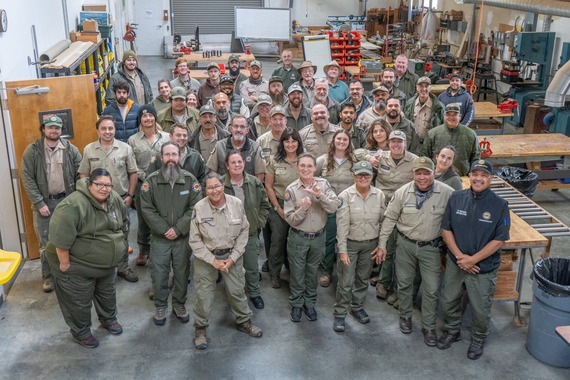 Introduction to Facilities Management Group 8 in the Mott Training Center Annex.
The Introduction to Facilities Management Skills Group 8 training course was held at the Mott Training Center Annex in Monterey, Dec. 4-8, 2023. This was the last maintenance class of the year. Training opened daily with class instructions and ended with group work labs in the afternoon.
Instructors included Tim White, Capital District restoration specialist, opening with historic preservation, on Monday, December 4, followed by Joanne Kerbavaz, senior environmental scientist, San Mateo Coast Sector, and Matt Bischoff, Monterey District historian III, discussing the Project Evaluation Form, California Environmental Quality Act, 5024 and National Environmental Policy Act. On Tuesday, Nate Tucker, health and safety officer, and Lance Chi, associated safety engineer, introduced participants to health and safety protocols. Jodi Whelchel, park maintenance chief III, San Diego District, followed with information regarding career paths and preparing for promotions within State Parks. Wednesday morning began with Case Belltawn, fleet manager, speaking about fleet management, followed by Branigan Schoppman, staff services manager I, Technical Services, discussing facilities management and Parks Infrastructure Database, On Thursday, Michael Patrick, senior architect, Acquisition and Development, introduced the class to Americans With Disabilities Act compliance and Sara (Skinner) Marshall, training specialist, Training Section, ended the morning with FOCUS training.
For the afternoon labs, students broke out into four groups and switched to different maintenance labs daily. Joe Lechuga, Mott training instructor, led the drywall and paint lab. Lawrence “Sparky” Ross, Mott training instructor, provided an introduction to electricity lab. Graham Payne, plant supervisor, Sierra District, demonstrated vehicle operations procedures and how to back up a trailer properly and safely. Vladan Glogovac, park maintenance worker II, Santa Cruz District, demonstrated how to cut, set and place different tile sets. Each class participant learned how to use the proper tools for each job and project lab safely.
Training Section staff would like to extend our gratitude to all our instructors and the Introduction to Facilities Management Group 8 class participants.
Please check your FOCUS calendar for the spring 2024 maintenance classes. Classes fill quickly. If you have any questions, please email me at Ricky.Roldan@parks.ca.gov.
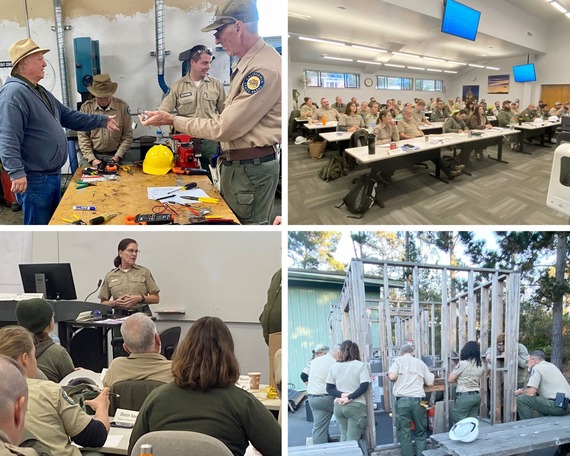 Top left: Mott training instructor Sparky Ross discussing the Electrical Lab. Top right: Introduction to Facilities Management Group 8 class in session. Bottom left: San Diego District Park Maintenance Chief III Jodi Whelchel discusses career paths and preparing for promotion. Bottom right: Santa Cruz District Park Maintenance Worker II Vladen Glogovac instructing class on Tile Lab installation.
  Email photos to the WeeklyDigest@parks.ca.gov.

|